Content
- 1 What diseases of perennial phlox exist?
- 2 Fungal diseases of phlox and how to deal with them
- 3 Phlox viral diseases and their control
- 4 Mycoplasma diseases of phlox and their treatment
- 5 Other diseases of perennial phlox and their treatment
- 6 Pests of perennial phlox
- 7 Prevention measures
- 8 Phlox varieties that are resistant to disease
- 9 Conclusion
Diseases of phlox with photographs and methods of treating them should be studied by all gardeners who are interested in breeding phlox of different varieties. Plants can be saved from many diseases and pests if the problem is recognized in time and treatment is started.
What diseases of perennial phlox exist?
Diseases affecting phlox can be divided into several groups:
- fungal diseases develop under the influence of spores, cause great damage, but respond well to treatment;
- viral diseases pose a particular danger, since it is very difficult to save an infected plant;
- diseases due to improper care, phlox can change color or stop growing due to a lack or excess of specific substances;
- diseases of mycoplasma origin, they are caused by organisms that are an intermediate link between viruses and bacteria.

Beautiful garden phloxes are susceptible to many diseases.
Fungal diseases of phlox and how to deal with them
Fungal diseases represent the largest group. Their manifestations are often similar.
Fomoz
When affected by Phoma, the lower leaves first turn yellow, and the shoots at the base turn brown. The leaves quickly begin to curl at the edges, become covered with black spots and dry out, the stem becomes brittle.

Phoma affects the plant from the bottom
If phomosis is noticed in the early stages, then perennials can be saved by treating with Bordeaux mixture 1% or with HOM. Gardeners also use another method - they cut off the still healthy top of the plant, treat it in a fungicidal solution and root it like a cutting.
Button rot
The disease is expressed in the fact that the lower leaves of the phlox wither, and the stems at the roots darken. Gradually, nutrition is irreparably disrupted, and the perennial dies.

Button rot begins to spread from the stem to the roots
The method of treatment when symptoms appear is as follows: you need to dig the phlox out of the ground, treat its roots with 0.5% Bordeaux mixture and replant it in a new place.If this method does not help, the only thing left to do is destroy the plant.
Powdery mildew
A characteristic symptom of the disease is the appearance of white spots on the leaves, similar to thick cobwebs or mold. The disease spreads from the top of the leaf to the base. As the disease develops, the plaque becomes gray, visible spots of mycelium appear in it, and the phlox quickly fades.

Powdery mildew leaves a white coating on the foliage
You can cope with powdery mildew using copper preparations - HOM solution or copper sulfate. If the perennial is not too severely affected, then the treatment method is effective.
Rust
When the disease appears, reddish-brown spots begin to appear on green leaves. As the disease progresses, their number increases, the spots merge with each other, and the affected areas dry out.

Rust abundantly stains the leaves with reddish-brown dots.
The best way to treat phlox is spraying with copper-containing preparations. In this case, you need to make sure that the liquid gets not only onto the plant, but also onto the soil.
Septoria
Fungal septoria spreads through plants from bottom to top. First, gray and brown spots appear on the leaves at the bottom. Over time, the spots begin to grow, and the disease spreads to the upper shoots.
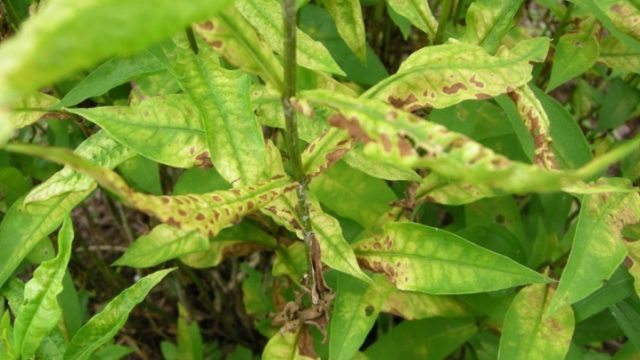
With septoria, phlox becomes spotted and turns brown.
Treatment of septoria is carried out with preparations containing copper - vitriol and HOM solution. If the disease is in the initial stages of development, this method helps to save perennials.
Wilt
Wilt, or verticillium wilt, is a very dangerous and common disease. The fungus attacks the root system and does not allow the plant to feed normally.First, the leaves of the perennial turn yellow, and then the stems themselves begin to turn brown and dry out.

Wilt is a disease that affects the roots of a plant, causing the shoots to wither
It is difficult to cure wilt, but in the early stages this method helps - you need to dig up the phlox, wash its roots and soak it in a biofungicidal solution. Then the perennial is transplanted to a new place, after adding Trichodermin to the soil.
If it is too late to save the phlox, then it must be destroyed immediately. The soil should be treated with fungicides and no other plants should be planted in this place, at least until next year.
Phlox viral diseases and their control
Viruses are dangerous because they are difficult to treat, but quickly spread to neighboring plantings. If characteristic symptoms appear in one of the plants, you need to act immediately.
Necrotic spotting
Necrotic spot disease manifests itself as brown spots affecting the leaves. At first, the spots do not exceed 1 mm in size, but they grow quickly.
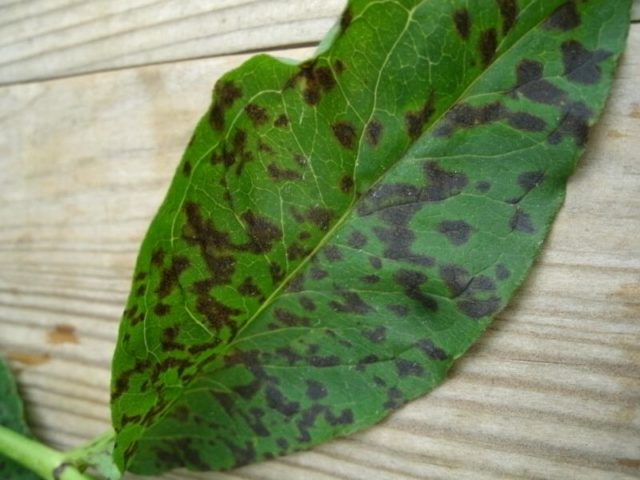
Necrotic spotting cannot be treated
Necrotic spotting is caused by the cucumber mosaic virus. The virus can get onto phlox from the soil where cucumbers used to grow, or together with insects. In this case, the disease is not treated - the affected phlox is simply eliminated, and the soil is thoroughly disinfected and no plants are planted in it throughout the season.
Ring spot
The viral disease is spread by nematode pests, and it manifests itself as ring-shaped spots on the leaves. When affected by the disease, the foliage becomes deformed, curls and falls off. The virus cannot be treated; the perennial is simply destroyed, and the soil is treated for nematodes.

You can recognize ring spotting by its characteristic circles and streaks.
Variegation
It appears as symmetrical radial stripes of a light shade that appear on the petals of the perennial. The plant loses varietal characteristics and degrades.
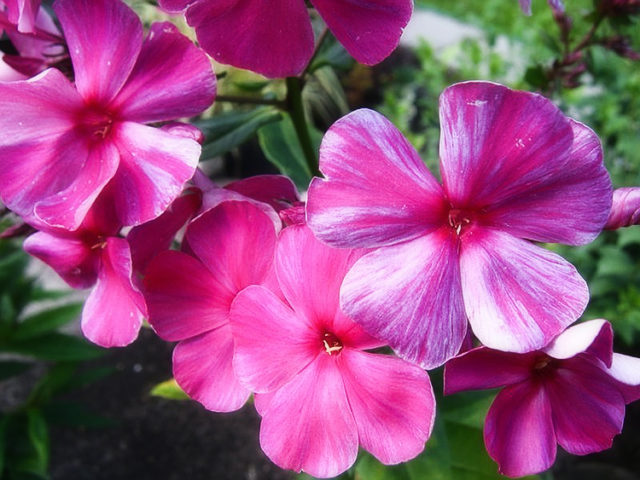
The appearance of light strokes on the petals indicates variegation
If the phlox shows signs of variegation, the perennial needs to be eliminated. It is impossible to carry out full treatment, but the virus can quickly spread to neighboring plants.
Threadiness
Threading is a viral disease in which the leaves become very thin, narrow, and become jagged along the edges of the leaf blades. Phlox stops blooming and stops growing, its shoots and stems become weak and fragile

When threadlike, the perennial foliage becomes thinner and the stems weaken
If characteristic symptoms occur, the diseased perennial is eliminated. The disease cannot be treated, and its contagiousness is quite high.
Mosaic
The disease manifests itself as irregularly shaped light spots appearing on phlox leaves. At the very beginning, the mosaic may even look beautiful, but the health of the phlox deteriorates very quickly. The leaves begin to turn yellow and thin, the stems become brittle, and eventually the weakened phlox dies.

Mosaic affects the leaves with light yellow-green spots
If the plant is not heavily infected, you can treat it with Bordeaux mixture. If there is no response to treatment, the phlox must be destroyed before it infects neighboring plantings.
Rattle
Rattle is a viral disease that causes light yellow stripes, spots, rings and half-rings to appear on the leaves.The virus spreads quickly, phlox slows down in development, begins to weaken and fade.

Rattle leaves light, uneven patterns on the foliage
Since rattleworm is a type of mosaic virus, the treatment method is the same. Phlox can be treated with Bordeaux mixture if the perennial has not suffered much damage. It is better to dig up a seriously affected plant and burn it.
Curly
At first, the virus appears as yellowish or black uneven spots on the leaves and browning of the veins. At later stages, the leaf plates begin to deform and twist in a spiral. As a result, the phlox stops flowering and stops growing.

When phlox foliage becomes curled, it becomes deformed and turns yellow.
Methods for treating curling suggest completely removing the affected leaves from the plant and treating the perennial with Bordeaux mixture. But treatment will only bring results if the virus has not had time to develop properly.
Mycoplasma diseases of phlox and their treatment
Mycoplasma diseases are dangerous because they affect the plant at the cellular level. Pathogenic organisms of mycoplasma are a cross between a virus and bacteria, develop very quickly and lead to the death of phlox.
Jaundice
The disease jaundice is carried by insect pests and infects the phlox from the inside. Under the influence of the pathogen, the plant stops growing, the leaves turn yellow and curl, and the flowers turn pale or green. With jaundice, phlox can produce numerous but weak side shoots; flower petals and stamens often elongate.

Jaundice is a mycoplasma disease with no cure.
There is no way to treat jaundice; the plant can only be protected from it prophylactically. If symptoms of the disease appear on the phlox, then all that remains is to destroy the perennial.
Other diseases of perennial phlox and their treatment
Not all illnesses are caused by fungi and viruses. Sometimes plants start to get sick due to improper care. For example, the health of phloxes weakens due to waterlogging or lack of moisture, due to poor soil or an excess of minerals.
Stem cracking
The disease is characterized by vertical cracks appearing in the lower part of the stem. Over time, they become larger and rise upward, and corky growths appear on the surface of the wound.
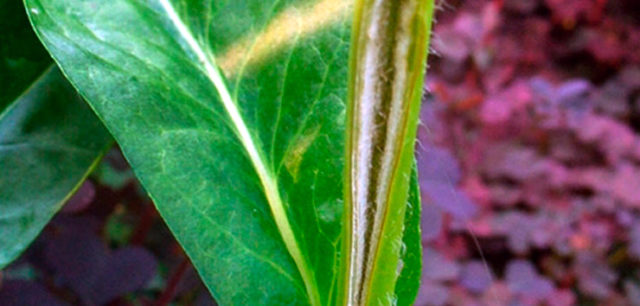
Cracking the stem does not prevent the growth of the perennial, but weakens its strength
The disease develops due to waterlogging of the soil, its acidification and excess nitrogen content in the soil. Therefore, for treatment it is enough to reduce the number of waterings and adjust the content of minerals in the soil.
Chlorosis
The disease develops on soils that are too poor, swampy and acidified. Leaves and shoots lose color and become yellow or white. A light border often appears on the leaf blades. The color changes because the plant does not receive the required amount of chlorophyll and cannot perform photosynthesis properly.

To treat chlorosis, you need to provide phlox with proper watering and feeding.
A reliable way to treat chlorosis is to review the watering regime and apply fertilizers.Typically, fertilizer containing zinc, lime, iron and magnesium is added to the soil.
Pests of perennial phlox
In addition to diseases, pests are dangerous for garden phlox. It is usually easier to deal with them, but it is important to notice the symptoms of damage in time.
Slugs
Gastropods feed on fresh leaves. Most often they infect flower beds after prolonged rains. In wet summers, it is recommended to regularly inspect the leaves of perennials, as well as loosen the soil around the phlox and eliminate weeds.

Slugs can seriously eat the green mass of a plant
If slugs do appear, the best way to get rid of them is to collect the pests by hand. To repel shellfish, you can sprinkle ash or lime along paths or between phlox bushes.
Cruciferous flea beetle
Small black parasites that live in the upper layers of the soil move to the stems and leaves of phlox in early spring. Cruciferous flea beetles are omnivorous and eat not only leaves, but also shoots, buds and flowers.

The cruciferous flea beetle feeds on all parts of phlox
A popular treatment method is treating the bushes and the soil around them with wood ash or slaked lime. You can also spray tobacco powder over the flowerbed.
Nematodes
Most often, pests attack the leaves of perennials; sometimes they can multiply in the roots. Nematodes are very thin and almost colorless; they are difficult to notice with the naked eye.
The presence of nematodes is determined by indirect symptoms - by swollen new growths on leaves and stems, by slower growth and shredding of flowers, by increased fragility of shoots. There is no treatment for phlox affected by worms; the only way is to destroy the plant.

Symptoms of nematode infestation appear late and there is no treatment available.
Slobbery Penny
The pest feeds on the juices of phlox foliage and interferes with the development of the plant. The pennitsa secretes an abundant secretion, it covers the leaves and further disrupts the processes of photosynthesis. Pest infestation occurs most often in dry weather.

You can find out about the presence of pennies by their characteristic mark.
The method of treatment for the appearance of pennies is to treat the perennial with insecticides or home remedies. It is important to spray several times at short intervals, this will destroy both the pest itself and its larvae.
Bronzovki
You can recognize a large beetle by its beautiful golden-green shell. In general, the bronze is considered a beneficial insect involved in the processing of plant residues. But at the same time, the insect feeds on the petals, shoots and peduncles of the phlox, and, therefore, causes harm to the perennial.

Bronzovka is a useful insect in general, but dangerous for phlox
Bronze birds fly throughout the warm season - from May to the end of August. To get rid of them, you can use the manual method and collect insects, or you can spray flowers and soil several times with insecticides.
Caterpillars
The threat to the leaves and flowers of phlox is posed by caterpillars - mainly different species of cutworm butterflies. They lay eggs on the stems, from which larvae hatch and feed on the plant juices.
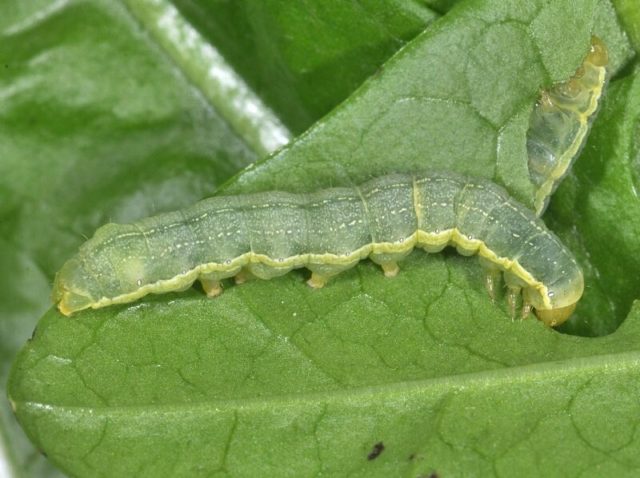
Numerous caterpillars feed on the foliage of ornamental phlox
You can recognize the presence of caterpillars by the characteristic holes on the leaves.Upon closer inspection, the pests themselves become noticeable. Treatment is carried out using the drugs Karate, Fastak and other chemicals; adult caterpillars are collected by hand.
Prevention measures
Not all phlox diseases are treatable. The most reliable way to protect flower beds is to carry out high-quality prevention and prevent infection.
Among the preventive measures are:
- annual autumn cleaning of the garden, it is necessary to collect and burn all plant debris on the site so that the remains of old shoots and leaves do not rot in the flowerbeds with phlox;
- compliance with the watering regime, although phlox loves moisture, fungi often develop in swampy soil;
- proper feeding of plants so that phloxes do not suffer from chlorosis or cracking; it is important not to overfeed them with nitrogen and not to acidify the soil.

One of the most important preventive measures is cleaning the garden from plant debris.
Spraying with special preparations plays an important role in prevention. If fungal spores or parasite larvae do appear in the soil, chemical agents will help deal with them even before symptoms appear.
Preventive treatment of phlox against diseases and pests
Preventive treatment of phlox is carried out several times a season, starting in early spring. It is performed according to the following algorithm:
- at the beginning of the growing season, at the end of March or in April, the soil in the flowerbed with phlox and in the adjacent areas is sprayed with a 0.2% solution of Fundazol, a 0.5% solution of Bordeaux mixture or a 3% solution of ferrous sulfate;
- after a week, the treatment is repeated again, also covering not only the phlox planting site, but also neighboring areas;
- 10 days after this, a third treatment with the same drugs is carried out.
Spring treatment by pouring the soil or spraying helps eliminate spores of most fungal diseases.
To protect phloxes from fungi, you can use systemic drugs Skor and Topaz. In this case, treatments are carried out twice before the plants begin to flower, in May and early June, and again after it ends - in August or September. The interval between treatments should be at least 10 days.

Flower beds with phlox need to be sprayed 3-4 times per season with breaks
Phlox varieties that are resistant to disease
Not a single variety of phlox has absolute invulnerability. But some varieties resist disease better than others. Among them:
- Starfire;
Starfire is a variety resistant to most fungal diseases
- Fog;
The lilac variety Fog is rarely affected by diseases
- Success;
Decorative variety Success is characterized by increased resistance to fungi
- Sandro Botticelli;
Purple variety Sandro Botticelli - hardy and disease-resistant variety
Even if the phlox variety is positioned as highly resistant to fungal diseases, agricultural practices must still be followed when growing. Irregularities in care endanger the health of hardy, proven varieties.
Conclusion
Diseases of phlox with photographs and methods of treating them help to navigate the numerous ailments of the culture.In many cases, the health of phlox can be preserved if the disease is recognized in the first stages and proven treatment methods are applied.












